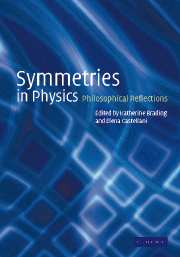Book contents
- Frontmatter
- Contents
- List of contributors
- Preface
- Copyright acknowledgements
- 1 Introduction
- Part I Continuous symmetries
- Part II Discrete symmetries
- 11 Classic texts: extracts from Leibniz, Kant, and Black
- 12 Understanding permutation symmetry
- 13 Quarticles and the identity of indiscernibles
- 14 Handedness, parity violation, and the reality of space
- 15 Mirror symmetry: what is it for a relational space to be orientable?
- 16 Physics and Leibniz's principles
- Part III Symmetry breaking
- Part IV General interpretative issues
- Index
12 - Understanding permutation symmetry
Published online by Cambridge University Press: 08 October 2009
- Frontmatter
- Contents
- List of contributors
- Preface
- Copyright acknowledgements
- 1 Introduction
- Part I Continuous symmetries
- Part II Discrete symmetries
- 11 Classic texts: extracts from Leibniz, Kant, and Black
- 12 Understanding permutation symmetry
- 13 Quarticles and the identity of indiscernibles
- 14 Handedness, parity violation, and the reality of space
- 15 Mirror symmetry: what is it for a relational space to be orientable?
- 16 Physics and Leibniz's principles
- Part III Symmetry breaking
- Part IV General interpretative issues
- Index
Summary
If a system in atomic physics contains a number of particles of the same kind, e.g. a number of electrons, the particles are absolutely indistinguishable one from another. No observable change is made when two of them are interchanged … A satisfactory theory ought, of course, to count any two observationally indistinguishable states as the same state and to deny that any transition does occur when two similar particles exchange places.
(Dirac, 1958, p. 207)Introduction
In our contribution to this volume we deal with discrete symmetries: these are symmetries based upon groups with a discrete set of elements (generally a set of elements that can be enumerated by the positive integers). In physics we find that discrete symmetries frequently arise as ‘internal’, non-spacetime symmetries. Permutation symmetry is such a discrete symmetry, arising as the mathematical basis underlying the statistical behaviour of ensembles of certain types of indistinguishable quantum particle (e.g. fermions and bosons). Roughly speaking, if such an ensemble is invariant under a permutation of its constituent particles (i.e. permutation symmetric) then one doesn't ‘count’ those permutations which merely ‘exchange’ indistinguishable particles; rather, the exchanged state is identified with the original state.
This principle of invariance is generally called the ‘indistinguishability postulate’ (IP), but we prefer to use the term ‘permutation invariance’ (PI).
- Type
- Chapter
- Information
- Symmetries in PhysicsPhilosophical Reflections, pp. 212 - 238Publisher: Cambridge University PressPrint publication year: 2003
- 16
- Cited by



